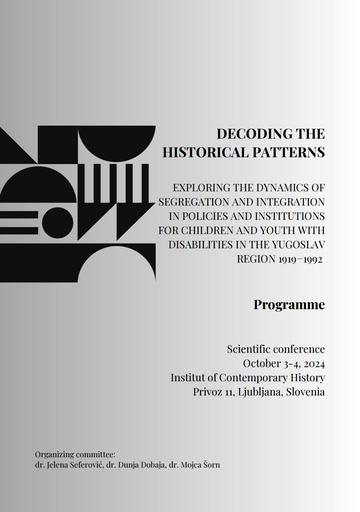/
Dogodki
/
Konference
Contrasting attitudes towards sensory impairments in Icelandic history


To delo avtorja Sólveig Ólafsdóttir je ponujeno pod Creative Commons Priznanje avtorstva-Nekomercialno-Deljenje pod enakimi pogoji 4.0 Mednarodna
Datoteke (1)
Opis
This paper explores the contrasting attitudes towards sensory impairments in Icelandic history, focusing on the differing treatment of deaf and blind individuals. Deafness, considered a familial trait, led to early developments in deaf education, including compulsory schooling legislation in 1817 and the establishment of a home school for the deaf in 1860. The Reykjavík Deaf School, founded in 1909, operated until 2002, despite facing allegations of abuse. In stark contrast, no formal education system existed for the blind until the Icelandic Association of Friends for the Blind established a school in 1933, which was state-supported only by the 1970s. Census data from 1890 to 1920 showed a blindness prevalence in Iceland ten times higher than other northern European countries. This disparity in treatment is attributed to Iceland’s historical isolation and limited technological access, which contributed to a unique societal context for sensory impairments. The study highlights the historical and cultural factors influencing the divergent educational provisions and societal attitudes toward deaf and blind individuals in Iceland.
Metapodatki (12)
- identifikatorhttps://hdl.handle.net/11686/71095
- naslov
- Contrasting attitudes towards sensory impairments in Icelandic history
- avtor
- Sólveig Ólafsdóttir
- soavtor
- Jelena Seferović (mod.)
- predmet
- senzorične motnje
- izobraževanje
- Islandija
- opis
- This paper explores the contrasting attitudes towards sensory impairments in Icelandic history, focusing on the differing treatment of deaf and blind individuals. Deafness, considered a familial trait, led to early developments in deaf education, including compulsory schooling legislation in 1817 and the establishment of a home school for the deaf in 1860. The Reykjavík Deaf School, founded in 1909, operated until 2002, despite facing allegations of abuse. In stark contrast, no formal education system existed for the blind until the Icelandic Association of Friends for the Blind established a school in 1933, which was state-supported only by the 1970s. Census data from 1890 to 1920 showed a blindness prevalence in Iceland ten times higher than other northern European countries. This disparity in treatment is attributed to Iceland’s historical isolation and limited technological access, which contributed to a unique societal context for sensory impairments. The study highlights the historical and cultural factors influencing the divergent educational provisions and societal attitudes toward deaf and blind individuals in Iceland.
- založnik
- Inštitut za novejšo zgodovino
- datum
- 04. 10. 2024
- tip
- video
- jezik
- Angleščina
- jeDelOd
- pravice
- licenca: ccByNcSa
